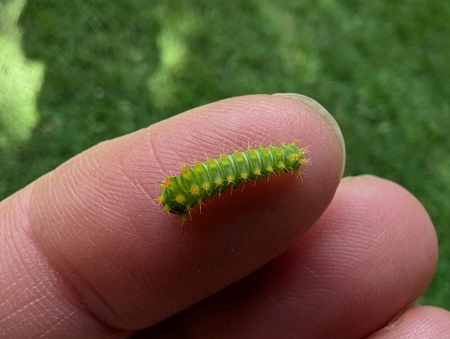
Good Natured: Insect Babies
Have you ever tried to match a picture of a baby to what s/he looks like as an adult?
This sort of thing is popular at baby showers and staff retreats; we even played it at the park district a few years ago. Recently, my brother and I have been playing our own version, going through old family photos and trying to decide, “Is this baby Aunt Ginny or Uncle Bill? Or Dad??"
It's fun, for sure, but believe you me naming or identifying babies can take an extraordinary amount of time in the workaday world of a nature nerd. The challenge increases exponentially when the baby has only a thin coat of peach-fuzzy fur or downy feathers. Or an exoskeleton.
My friends and I actually had occasion to play a round of Name that Baby a couple of weeks ago, during a walk at LeRoy Oakes Forest Preserve in St. Charles. We were following a narrow path along Ferson Creek—one some local naturalists refer to as the Danger Trail—and after scrabbling up a steep incline made our way back down to creek level. That's when Nature Nerd Sarah noticed a baby had joined us.
Not quite a neonate (the word for babies that hatch) but definitely nowhere near its larger and more recognizable life stages, this wee one must have fallen off a leaf as we tromped by. Its bright color contrasted sharply with my navy blue T-shirt (and matched the green Hickory Knolls logo), and its general shape plus legs and prolegs gave away its identity of a caterpillar—the larva of a Lepidopteran. But with somewhere in the neighborhood of 2,000 species of butterflies and moths living here in Illinois, how were we going to figure out just whose baby this was?
Thank goodness for family traits. Just as some human babies carry on the genes for, say, red hair and freckles, insect babies do the same. Caterpillars of the Sphingidae, or sphinx moth family, for example, typically have what looks like a little spine poking up from their bottoms. BugGuide.net calls this feature a “prominent dorsal horn" and notes that most larvae in this family are called hornworms. The caterpillars you find on your tomatoes belong to this group.
Caterpillars in the subfamily Arctiinae, a name derived from the Greek word for bear, are fuzzy; the most famous of these are—you guessed it—the woolly bears. Inchworms, with their distinctive movements, belong to Geometridae (geo = earth, metron = measure). You get the picture.
(A couple other things to keep in mind…Of our 2,000-ish species of Lepidopterans, only about 150 are butterflies. The odds are definitely with the moths. Also, some caterpillars have very specific diets. Monarch caterpillars for instance feed only on milkweed, and black swallowtail caterpillars need plants in the parsley family. So paying attention to where the caterpillar is found can be helpful too. Unless of course it's on your shirt.)
Getting back to the baby on our walk, closer inspection revealed that it displayed quite a few notable traits: it was green, and it had two rows of bumps with stiff hairs, or setae, going down its back. It was also, um, chunky for its size. I was 100% certain this baby belonged to the subfamily Saturniinae—the giant silkmoths.
But from there, things got tough.
Just like Aunt Ginny, Uncle Bill and Dad, this little caterpillar bore a strong resemblance to other members of its family, primarily those most common in our area: the cecropia, the luna and the polyphemus.
All three have knobs and bristles early on—a trait that helps deter predators—and all feed on trees like oak, hickory and maple. After much poring over references, I was able to eliminate cecropia, as at this small size they're yellow, not green. But luna? Or polyphemus? The quest continued.
Online experts at BugGuide and iNaturalist were split, with answers leaning toward polyphemus. It wasn't until I consulted Bill Oehlke, a Canadian gentleman maintains the website World's Largest Saturniidae Site that the baby name question was resolved. Sort of.
(Fun twist: My dad, aunt and uncle—in fact the majority of babies born in Wheaton, IL, a century ago—were delivered by Dr. Oelke. Slightly different spelling, same pronunciation, and same depth of knowledge. They just happen to focus on different taxonomic classes.)
At any rate... With more than 70 years of mothing under his belt, as well as extensive experience raising many species from egg to adult, Bill could tell immediately that while we could come close, we wouldn't be able to make a full species ID. In his email he explained, “It is either luna or poly. Need a lateral view to tell them apart at this stage and even then it can be difficult."
I know they say that close only counts in horseshoes and hand grenades, but I think it works for moth ID too. Let's consider this case closed, for now. But you can bet I'll be out again soon, looking for this baby and its kin as they reach later life stages. Anyone up for a game of Name that Cocoon?
Pam Otto is the outreach ambassador for the St. Charles Park District. She can be reached at potto@stcparks.org.
.

